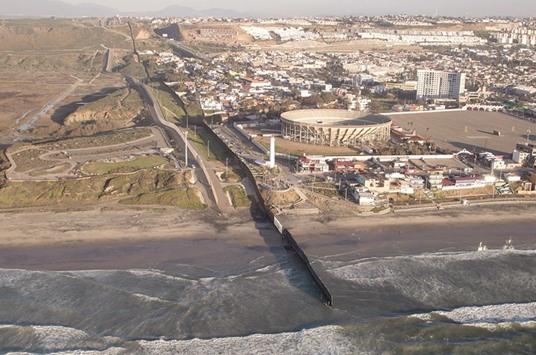Competition to build President Donald Trump’s border wall is underway, with 467 companies across America submitting bids and designs to construct what was a centrepiece promise of Trump’s campaign.
Fencing and barriers are nothing new along the US-Mexico border. For nearly 30 years, fencing made from landing mats, steel mesh and concrete-filled steel bollards have been erected along nearly 700 miles of the border.
Much of that was constructed between 2007 and 2015, when the government spent an estimated $2.5 billion on border fencing projects. The work was done in populated border areas, including San Diego, and along desert mesas and in small towns in Arizona and Texas.
Much remains unknown about Trump’s wall, like what it would look like, how much it would cost, and how much more of the 2,000-mile Southwest border it would cover.
Yet a look back at some of the fencing projects undertaken during the border building boom and what has happened since they were completed can give a sense of what may be in store for border residents if the wall is constructed.
From Smuggler’s Gulch in San Diego, which was filled in with nearly 2 million cubic yards of dirt to form a massive berm after a years long legal battle, to the Lower Rio Grande area of Texas, border barriers and fencing have helped reduce the number of people entering the United States illegally.
And they have also left a mark on the landscape that critics said have led to other problems such as flooding and erosion.
“It’s not just build the wall and forget about it,” said Oscar Romo, a researcher with UC San Diego who co-ordinated the Tijuana River National Estuarine Research Reserve’s coastal training program for about a decade. “There are consequences, and we are paying for some of those consequences.”
Smuggler’s Gulch
In July 2009, a group of jubilant federal officials gathered in Smuggler’s Gulch for a ceremonial ribbon-cutting ceremony atop a giant earthen berm.
It marked the completion, in less than a year, of a border construction and fencing project that sealed off what had for decades been a prime route for smugglers and unauthorised immigrants.
Contractors scraped about 1.5 million cubic yards of dirt from two mesas bordering the canyon, constructing a berm more than 100 feet high. They also added a second layer of steel mesh fencing, augmenting an existing fence, and constructed a road for US Border Patrol vehicles at a cost of $48.6 million.
The Smuggler’s Gulch work was one of the more expensive stretches of fencing constructed on the border, costing about $16 million per mile. And one of the most controversial.
The project faced stiff opposition, including a 2004 lawsuit filed by the Sierra Club, San Diego Audubon Society and other environmental groups. They contended the project would add large amounts of sediment and damage to the nearby Tijuana River Estuary.
But in 2005, Congress passed legislation that allowed the US Department of Homeland Security to waive all laws — state, local and federal — that could impede the construction of border fencing projects.
After the ribbon cutting ceremony, contractors and some of the federal officials left. But the controversy did not.
In the fall of 2009, critics complained that the government had botched a critical aspect of the work — reseeding the barren dirt slopes with vegetation to control erosion and runoff.
The then-leader of the California Coastal Commission fired off a letter in October saying the re-vegetation plan had “failed miserably,” largely because after seeding the slopes the federal government had not irrigated them properly.
Congresswoman Susan Davis, D-San Diego, also wrote a letter, as did the manager of the estuary reserve, expressing concern that the bare slopes would increase sediment flowing to the estuary. Storms the previous winter, when construction was underway, flooded the river valley and left behind what residents said was an unusual amount of mud.
In response, US Customs and Border Protection officials said they were following a proper plan to revegetate the slopes and care for the environment.
Today, the berm slope is thick with vegetation, covering more than 70 percent of the area, said Mark Endicott, supervisory Border Patrol agent for the San Diego Sector.
The work was done over the past five years in conjunction with the US Fish & Wildlife Service as well as the San Diego County and California parks departments.
The plants have lessened the amount of sediment flowing into the estuary, Endicott said. Erosion pins that measure slope stability showed an average change in the height of the soil of 0.5 centimetres in 2014 to 2015, then 0.1 centimetres the following year.
“The successful revegetation of the area has resulted in little to no sedimentation into the estuary as a result of the fence project,” Endicott said.
Romo, who has worked in the valley for three decades, said other problems have occurred since the fence was built.
A concrete culvert constructed at the base of the berm now captures water from Mexico and the US and funnels it into a channel. Romo said the culvert has increased the velocity of the water flowing into the channel, with damaging effect. The channel is eroding quickly, and more importantly the increased speed of the water is pushing the trash and sediment farther into the estuary than before.
Trash is now building up in parts of the reserve where it was not before, Romo said. Hauling the trash out of the environmentally sensitive estuary will be tedious and difficult, but eventually it will have to be done, he said.
But the fence has achieved its main purpose — to help reduce the number of unauthorised immigrants entering the US, Endicott said.
The number of apprehensions in the San Diego Sector has dropped significantly, from 118,721 in 2009 when the fencing was complete to 31,891 last year.
That drop tracks an overall decline in apprehensions across the Southwest border that has been trending down for a decade, before beginning to tick up slightly in 2015.
Organ Pipe in Arizona
Around the time that work on Smuggler’s Gulch was starting, another section of fence was being constructed to the east in Arizona.
Organ Pipe Cactus National Monument lies next to the international border, about two hours west of Tucson. In early 2008, the government built 5.2 miles of steel mesh fencing there. Activists and monument land managers said at the time they were concerned that the design would block the flow of water across the border, possibly causing floods.
But the Homeland Security Department went ahead with the $21.3 million project built by Omaha, Nebraska, company Kiewit. The same company built the Smuggler’s Gulch project.
A storm in July 2008 dumped about 2 inches of rain in less than 90 minutes around the border crossing town of Lukeville. The fence, even with wide iron grates at the base to allow water to flow through, essentially acted like a dam. Debris stuck against the bottom, blocking the water flow and causing flooding to the nearby port of entry as well as at businesses in Lukeville.
One company unsuccessfully sued the government for $6 million for flood damage and property loss. In the aftermath, the government installed a series of gates in the fence near Lukeville that would be lifted in times of flooding to allow water to pass through.
Then, in August 2011, another summertime storm hit — but the gates didn’t work as planned. Debris again built up at the base of the fence causing not only flooding but also knocking over a 40-foot-long section of the fence.
Randy Serraglio, Southwest conservation advocate for the Center for Biological Diversity, said the problem at Organ Pipe stemmed from the Department of Homeland Security not listening to local land managers at the monument site and area landowners who warned about the flooding dangers.
“They were told by the land manager at Organ Pipe it was not a good location to put up the infrastructure they were trying to build there,” Serraglio said. “They just really rushed forward blindly with construction.”
There has been no reported flooding in the area for several years. Border agents now routinely go on patrol and clear debris from the base of the fence, Serraglio said.
Lessons learned
Trump’s proposal for a wall is moving quickly but also hitting resistance. Customs and Border Protection is reviewing bids and hopes to select by June up to 20 companies to construct prototypes in San Diego.
In testimony this month before Congress, Homeland Security Secretary John Kelly said a solid border wall would not be built “from sea to shining sea.” Instead, he said, the department would build a wall where agents and immigration enforcement officials say one is needed.
Those who are concerned about more fencing along the border welcome such comments. “DHS should take away from what happened at Organ Pipe that there are some places where you should not build a border wall. Period,” Serraglio said. The pressure to begin construction though is troubling to some. Imperial Beach Mayor Serge Dedina, who is also the executive director of the environmental group Wildcoast, which opposed the Smuggler’s Gulch project, said the rush to build and not weighing thoroughly what the potential problems are is the wrong course.
“That is what I get concerned about, in this rush to build a wall,” Dedina said. “We are talking about some of the most remote parts of the country. It’s simplistic to think you can plan this kind of a fence project without thinking through the engineering and earthworks that will be needed in some areas.”
The federal government spent $2.5 billion to build nearly 700 miles of fencing. Estimates for the wall Trump wants to build vary widely, from a $21 billion Homeland Security Department estimate to $38 billion in an MIT study. —The San Diego Union-Tribune/TNS

BORDERING INTO THE WATER: An aerial photo flight from Andrade, California on the east end of the US-Mexico border in California to the Pacific Ocean, where the border fence ends in the water. This is where the fence ends, at the Pacific Ocean in the Las Playas section of Tijuana, which is the northwestern most point in Mexico.


